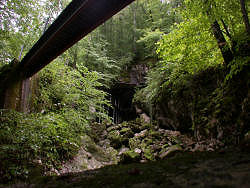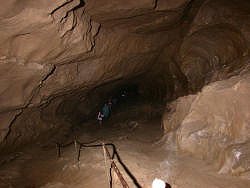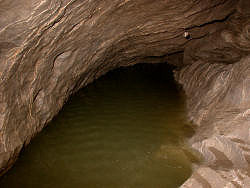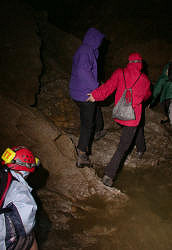Hölloch
Useful Information




| Location: |
Hölloch Center, Stalden 14, 6436 Muotathal
Follow the only road through the Muotathal, after the homonymous village keep left to Stalden. Ticket Office at the road Pragelstraße, short hike along the river upstream to the cave entrance. (46.9764802, 8.7888538) |
| Open: |
Hölloch Short Tour:
JUN to SEP Wed-Sun 10, 13, 15:30. All other tours: APR to OCT on select days after appointment. For large enough groups all year. Online Booking mandatory. [2025] |
| Fee: |
Hölloch Short Tour:
Adults CHF 39, Children (16-19) CHF 25, Children (5-15) CHF 15. Hölloch Beginners Tour: Adults CHF 88, Children (16-19) CHF 58, Children (6-15) CHF 38. Hölloch Parcours: Adults CHF 135, Children (16-19) CHF 78, Children (9-15) CHF 58. Hölloch Challenge: Adults CHF 195, Children (16-19) CHF 138, Children (10-15) CHF 78. Hölloch Team Experience: Adults CHF 175. Hölloch Team Building: Adults CHF 485. [2025] |
| Classification: |
 Karst Cave Karst Cave
 river cave,
cave system. river cave,
cave system.
 The Most Expensive Show Cave The Most Expensive Show Cave
|
| Light: | none, carbide lamps and headlamps provided. |
| Dimension: | L=209,597 m, VR=1,033 m, T=6 °C. |
| Guided tours: |
Hölloch Short Tour:
D=2 h, VR=100 m, L=1,400 m, MinAge=5. Hölloch Beginners Tour: D=3 h, MinAge=6. Hölloch Parcours: D=3.5 h, Min=6. MinAge=9. Hölloch Challenge: D=6 h, Min=6, MinAge=10. Hölloch Team Experience: D=4 h. Hölloch Team Building: D=6-7 h. |
| Photography: | allowed |
| Accessibility: | no |
| Bibliography: |
Urs Möckli (2000):
Hölloch,
AS Verlag & Buchkonzept AG, Zürich; ISBN: 3905111470.

 amazon.de amazon.de
Alfred Bögli (1965): Im Banne der großen Höhle, Spectrum Verlag Stuttgart, 154pp. 
Urs Möckli, Hg. (2000): Hölloch - Naturwunder im Muotatal, Zürich, 2000. 
|
| Address: |
Trekking Team AG, Hölloch Center, Stalden 14, 6436 Muotathal, Tel: +41-41-390-40-40.
E-mail: |
| As far as we know this information was accurate when it was published (see years in brackets), but may have changed since then. Please check rates and details directly with the companies in question if you need more recent info. |
|
History
| 1875 | discovered by the Bergbauer (farmer) Alois Ulrich. |
| 1900 | development works by a Belgian-Swiss corporation cost 1 Mio Gold Franks. |
| 1904 | surveyed length: 4 km. |
| 1909 | Belgian-Swiss corporation failed because of too little visitors. |
| 1910 | paths and electric light destroyed by a flood. |
| 1945 | modern exploration by Professor
 Alfred Bögli
and other speleologists. Alfred Bögli
and other speleologists.
|
| 1952 | surveyed length: 25 km. |
| AUG-1952 |
 Alfred Bögli
and three companions trapped by a flood. Alfred Bögli
and three companions trapped by a flood.
|
| 1966 | surveyed length: 85 km. |
| 1995 | surveyed length: 170 km. |
| 1995 | bought by the Draganits brothers. |
Description








The Hölloch is at the moment surveyed for about 210 km and is thus the longest cave system in Switzerland. 20 years ago, while still 20 km shorter, it was also the longest cave of Europe and the 4th longest cave in the world. Today it’s the 12th longest in the world and the second longest in Europe [2025]. Such superlatives are volatile, and change frequently, still they state to be "the largest cave in Europe" on their website [2025]. The superlative that it is the most expensive show cave in the country on the other hand is quite stable.
It is located in the Muotatal, a karst area with about 20 km². The lower level is a river cave, the cave entrance is a resurgence. The oldest parts of the cave system are about one million years old. The best time for visiting the Hölloch is obviously in winter, because there is a much lower risk of floods. Snow melt and heavy rains should be avoided.
This page is about the show cave, which means the 2 h tourist tour called Hölloch Short Tour. It is offered all year on certain days, primarily on weekends, but it depends on the season and the expected number of visitors, especially if there are school holidays. The schedule is quite complicated so we recommend to have a look at their online booking system. Reservation is mandatory, it is best done with this online booking system, but it’s also possible to make a reservation by email or phone. Obviously the water level influences the tour, floods are possible all over the year, but mostly they happen in spring. They may restrict the tours or make them impossible. During times of snow melt or after heavy rains, an advance call or an email are advisable. Tours are made, even if not the whole trail is dry, but it may not be possible to visit all passages. The following description is from a visit in 2006, there may be some minor changes after 20 years. Especially the entrance was rebuilt some years ago.
The visitors meet ten minutes before the trip at the ticket office, only 50 m from the old cave hotel.
The visitors are introduced into the cave with a complete map of the 191 km of the cave, which covers two walls of the room.
The other walls show pictures of various floods.
During a flood the cave fills up to the show cave entrance, and 10 to 15 m³ of water per second rush out of the entrance.
In summer 2005 there was an extraordinary flood, said to have been the biggest flood of the millennium.
It also affected the cave, with a peak yield of 20 cubic meters through the entrance door.
The witnesses described it as a rectangular beam of water out of the door.
We had the luck to visit the cave at high water.
The path was closed by water half down the main passage.
The luck was not the fact to miss half of the cave, but the way how the closed passage made sounds.
Approaching the almost closed siphon we heard a roaring noise.
First it sounded like a subway train, then like a watermill.
When we finally reached the siphon we heard a deep roaring noise with a slow rhythm, about two beats per second.
The water filled the passage except for a 20 cm wide and 10 cm high gap at the ceiling.
The huge cave system behind the siphon had a different air pressure than in front, and so air was blowing through that small hole.
The air current produced waves which closed the hole, and the constant rhythm of waves combined with the airstream produced a sound similar to a didgeridoo.
The sound was extremely loud and bounced off the walls of the passage.
An impressive experience.
This sound is extremely rare, it happens only at a certain water level.
If the water level had been 20 cm higher, the siphon would have been completely closed, without air flow and noise.
If the water level had been 20 cm lower, there would have been enough space for the air flow and no noise would have been emitted.
And obviously the existence of the air current is important.
There are various reasons for air movement in caves, but the strength depends primarily on the size of the cave.
The Hölloch is really huge, and so there is the possibility for heavy wind, produced by different air pressure in different parts of the cave.
One explanation is the change of the air pressure outside, caused by the weather.
There was bad weather outside, but it went better, which is always connected with a rise of air pressure.
Another possible effect is the change of the water level.
The flood was ending, water level going down, formerly water filled passages becoming dry.
The air had to flow into the cave, and because of the size of the cave system, the amount was rather high.
Being a river cave, subject to various floods, the cave has no speleothems.
The only speleothems were brought in from
 St. Beatushöhlen,
just to be able to show the visitors a stalagmite and a stalactite.
The cave walls are inclined, as the limestone was folded by the alpine orogeny and the layers are now almost vertical.
Most of the path was carved into the rock, and there are even two tunnels, one for the entrance and a second that winds down from the top of a steep chamber to the centre.
The path goes up and down very often so visitors should be fit enough able to handle those descents and ascents.
The floor is sometimes a little rough, there may be sand, clay, rubbles and even passages which have flooded floors.
Sturdy shoes are required, rubber boots are probably even better.
The cave is very cold and wet, warm clothes, preferably fleece pullovers, are essential.
There is no light, although the porcelain insulators of the historic lighting are still in place.
Some visitors are equipped with carbide lamps, which is more or less to produce a sort of nostalgia.
Also, they explain how such a carbide lamp works,
children get less difficult headlamps.
St. Beatushöhlen,
just to be able to show the visitors a stalagmite and a stalactite.
The cave walls are inclined, as the limestone was folded by the alpine orogeny and the layers are now almost vertical.
Most of the path was carved into the rock, and there are even two tunnels, one for the entrance and a second that winds down from the top of a steep chamber to the centre.
The path goes up and down very often so visitors should be fit enough able to handle those descents and ascents.
The floor is sometimes a little rough, there may be sand, clay, rubbles and even passages which have flooded floors.
Sturdy shoes are required, rubber boots are probably even better.
The cave is very cold and wet, warm clothes, preferably fleece pullovers, are essential.
There is no light, although the porcelain insulators of the historic lighting are still in place.
Some visitors are equipped with carbide lamps, which is more or less to produce a sort of nostalgia.
Also, they explain how such a carbide lamp works,
children get less difficult headlamps.
The cave walls are mostly limestones with frequent calcite fissures. The fissures are a result of the tectonic stress during the orogeny. Fractures in the rock were healed by calcite. And several layers of the rocks also contain a huge amount of fossils, especially various kinds of brachiopods.
This cave was not known since prehistoric times, despite its size the entrances are hard to reach and require climbing skills. The lowest entrance was discovered in 1875, by the local farmer Alois Ulrich, who was working on an Alpe, the typical Swiss high pastries. On his way down into the valley, to his farm, he had to cross a deep and dry ravine. He did this many times over the years, and normally it was no problem, but sometimes the dry ravine was water-filled. It was impossible to cross the turbulent and powerful brook, so he followed the ravine uphill, hoping that he would find a place where he could cross. And really, at some point the water vanished, and he was able to cross. When he became older, he thought about it: there was a place where the water emerged from the rock, in enormous amounts. This is only possible if there is a cave, which allows a lot of water to flow through. And when there is no river flowing out, the cave is air-filled, and it is possible to enter. He searched a while and then found the so-called "natural entrance". During the next decades the cave was explored and finally, at the turn of the century about four kilometers were known and surveyed. The name was given to the cave by the discoverer, he said the cave was "hel", which is a local dialect term and means slippery. So what he really said, was that the cave was slippery, but the German explores thought it meant hell, and so the cave was named Hölloch (hellhole) in literature and the name was born.
In 1900 a Belgian-Swiss corporation started a large scale development of the cave for tourist use. They built the Hôtel des Grottes in the little village Hinterthal. A path was built from the hotel up the dry ravine to the cave entrance, which crosses the ravine several times on bridges. In the cave concrete paths, stairs, and electric light were installed, a siphon was blocked by a concrete wall. Several tunnels were built to avoid dangerous parts of the cave. They also planned a railroad inside the cave for the following years. But the railroad was never build. The number of visitors was much lower than expected, only few tourists travelled into this remote valley to see the cave. The income did not match the enormous investments, and after a few years the company was ruined. Only one year after the closure, the several metre thick wall at the siphon was destroyed in a flood, and most of the electric system too.
The cave remained almost untouched for decades, until it was rediscovered by the young geologist
 Alfred Bögli
in 1945, at the end of World War II.
He revived scientific exploration and extended the cave significantly.
In August 1952
Alfred Bögli
in 1945, at the end of World War II.
He revived scientific exploration and extended the cave significantly.
In August 1952
 Alfred Bögli
and three companions were trapped by a flood.
They had to wait for 10 days until the water level sank, and they were able to pass the siphon.
At the end of their imprisonment they were some kilo lighter but famous.
Radio and newspapers published all details of several rescue operations.
Alfred Bögli
and three companions were trapped by a flood.
They had to wait for 10 days until the water level sank, and they were able to pass the siphon.
At the end of their imprisonment they were some kilo lighter but famous.
Radio and newspapers published all details of several rescue operations.
 Alfred Bögli
wrote a very interesting book about this 10 days inside the Hölloch (Im Banne der großen Höhle, see bibliography above).
Alfred Bögli
wrote a very interesting book about this 10 days inside the Hölloch (Im Banne der großen Höhle, see bibliography above).
A few years ago there were numerous guided tours into the Hölloch offered by different operators, but it seems today only one operator remains.
The Trekking Team AG has built a new wooden Visitor Center with a museum right below the cave entrance.
There is a show cave tour which shows the entrance part of the cave which was developed around 1900 by this Belgian-Swiss corporation.
There were only minor repairs of the trails, and there is no electric light.
But the Hölloch is famous for numerous cave trekking trips, which differ in length (three hours to two days) and difficulty.
There are tours for learners, tours for skilled, visits with food and drink, and even music.
Some are called "team building tours" and intended for companies.
They also offer tours into other caves, for example the
 Nidlenloch.
While the season is during summer, with fixed dates for individuals, there is all year the possibility for groups to get a tour.
Actually there are special Winter Expeditions, because when the mountains are covered in snow the water inside the cave has the lowest level.
Nidlenloch.
While the season is during summer, with fixed dates for individuals, there is all year the possibility for groups to get a tour.
Actually there are special Winter Expeditions, because when the mountains are covered in snow the water inside the cave has the lowest level.
 Search DuckDuckGo for "Hölloch"
Search DuckDuckGo for "Hölloch" Google Earth Placemark
Google Earth Placemark Hölloch - Wikipedia (visited: 29-MAR-2025)
Hölloch - Wikipedia (visited: 29-MAR-2025) Cave tours in the largest cave in Europe (visited: 29-MAR-2025)
Cave tours in the largest cave in Europe (visited: 29-MAR-2025) Index
Index Topics
Topics Hierarchical
Hierarchical Countries
Countries Maps
Maps